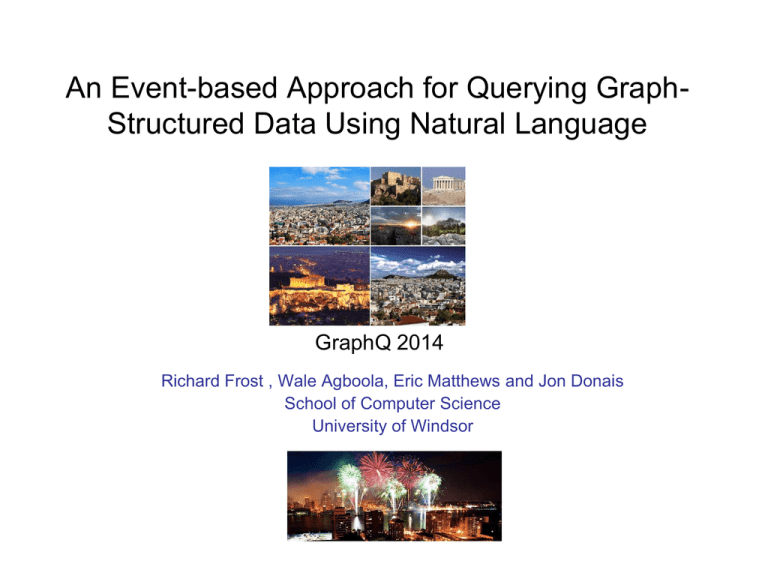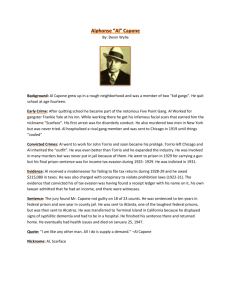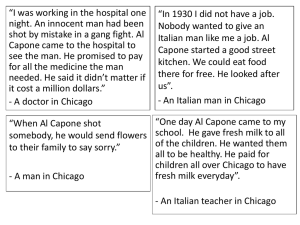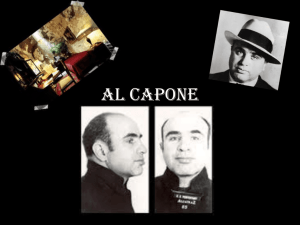Powerpoint Slides. - School of Computer Science
advertisement

An Event-based Approach for Querying GraphStructured Data Using Natural Language
GraphQ 2014
Richard Frost , Wale Agboola, Eric Matthews and Jon Donais
School of Computer Science
University of Windsor
Natural-Language Interfaces to triplestores
Translate NL to SPARQL – Problem 1
“Who married Al Capone in 1918?” prepositional phrase
⇩ translation
SPARQL QUERY
↕
SPARQL endpoint
<http://dbpedia.org/resource#Al_Capone>
<http://dbpedia.org/ontology/spouse
<http://dbpedia.org/resource#Mae_Capone> .
-----------------------------------------------------------------------------------------How do we add the data representing the prepositional phrase?
<….Al_Capone> <year_married> <…1918> .
Not adequate as Capone could have married twice.
ANSWER: Use some version of reification
BUT complicates translation from NL to SPARQL
GraphQ 2014
Natural-Language Interfaces to triplestores
Translate NL to SPARQL – Problem 2
“Who joined every gang that was joined by Torrio and stole
a car in 1918 or 1920 in a borough of New York?”
⇩
SPARQL QUERY
-----------------------------------------------------------------------------------------Too complicated – chained complex prepositional phrases with
arbitrarilty-nested quantifiers?
We are unaware of any system that can do this.
ANSWER: Do not use SPARQL
Evaluate the NL queries directly w.r.t. the triplestore
GraphQ 2014
A Solution to Problem 1
Event-Based Triplestores – a form of reification
[("event1000","type",
"born_ev"),
("event1000", "subject", "capone"),
("event1000", "year",
"1899"),
("event1000", "location","brooklyn"),
("event1001", "type",
"join_ev"),
("event1001", "subject", "capone"),
("event1001", "object", "fpg"),
("event1002", "year",
"1908" ),
("event1004", "type",
"steal_ev"),
("event1004", "subject", "capone"),
("event1004", "object", "car_1"),
("event1004", "year",
"1908"),
("event1004", "location","brooklyn"),
("event1005",
("event1006",
("event1006",
("event1006",
("event1007",
("event1007",
("event1007",
("event1005",
("event1010",
("event1010",
("event1010",
("event1011",
etc.
GraphQ 2014
”type",
"type",
"subject",
"object",
"type",
"subject",
"object",
“subject”,
"subject",
"object",
"type",
"subject",
“smoke_event"),
"membership"),
"car_1"),
"car"),
"membership"),
"fpg"),
"gang"),
“capone”),
"capone"),
"person"),
"membership"),
"torrio"),
Solution to Problem 2
Direct Evaluation of NL Queries w.r.t. Triplestore
“Who stole a car in 1918 or 1920 in a borough of New York?”
⇩parser⇩
“Who (stole (a car) [(in (1918 or 1920), in (a (borough (located_in New_York)))])?”
⇩
⇩
⇩ ⇩
⇩
⇩
λ… ( λ… ( λ… λ…) [(λ… ( λ…
⇧
⇩
⇩
⇩ ⇩
λ…
λ… ), λ …(λ…( λ…
⇧
⇩
(
⇧
⇩
⇩
λ…
λ…
)))])
⇧
TRIPLESTORE
Where
λ…
are functions (which are the denotations of English words)
based on an efficient version of Montague semantics
Some functions are defined in terms of triplestore retrieval operations:
GraphQ 2014
⇧
Basic Triplestore Retrieval Functions
getts_1 (ANY, REL “subject”, ENT “capone”)
=> {(1000, REL “subject”, ENT “capone”),
(1001, REL “subject”, ENT “capone”), etc.
getts_3 similar.
getts_1 and getts_3 are used to define other basic retrieval operators.
Defs in the paper..
Example uses of other retrieval operators:
get_subjs_for_events {EV 1000, EV 1009} => {ENT "capone", ENT "torrio"}
get_members
“thief_set”
=> {ENT “capone"}
get_subjs_of_event_type
“born_ev”
=> {ENT “capone”}
We can now define semantics using these basic operators
GraphQ 2014
Definitions of the denotations of Words
We use the notation of set theory in place of lambda expressions
thief
= get_members “thief_set"
e.g.
thief => {ENT “capone”}
smokes
= get_subjs_of_event_type
“smoke_ev”
e.g.
smokes => {ENT “capone”}
capone setofents = (ENT "capone") ∈ setofents
e.g.
capone smokes => True
a
nph
vbph
= #( nph ⋂ vbph) ~= 0
term_and tmph1 tmph2 = f where
f setofevs = (tmph1 setofevs) & (tmph2 setofevs)
e.g.
((a thief ) $term_and capone) smokes
GraphQ 2014
=> True
Our new semantics – major contribution 1
An explicit definition of the denotation of transitive verbs
join tmph
= { subj | (subj, evs) ∈ (make_image join_event)
&
tmph ( ⋃ {map thirds (getts (ev, REL "object", ANY)) | ev ∈ evs})}
where, for example: make_image
“join_ev”
=> {(ENT “capone”, {EV 1001, EV 1003}), (ENT “torrio”, {EV 1009})}
e.g.
join (a gang) => {ENT “capone”, ENT “torrio”}
GraphQ 2014
Major contribution 2: Prepositional phrases
Simplified example – a single prepositional phrase
steal_with_time tmph date
= {subj | (subj, evs) ∈ image_steal &
tmph ( ⋃ {thirds (getts (ev,REL"object",ANY))
| ev ∈ evs
&
date(thirds ( getts (ev,REL "date", ANY)))})}
The date argument is used to “filter” the events.
e.g. steal_with_time (a car) (date_1918) => {ENT "capone"}
GraphQ 2014
The result: A wide range of English NL queries
We have implemented simple case of prepositional phrases in Haskell – with
an in-program triplestore.
e.g. “Which gangster who stole a car in 1915 or 1918 joined a gang that was
joined by Torrio?”
⇩manual insertion of brackets
which (gangster $that (steal_with_time (a car)
(date_1915 $term_or date_1908))
(join (a (gang $that (joined_by torrio))))
⇩
{ENT “capone”}
GraphQ 2014
Next steps
1. Extend implementation to include chained prepositional phrases such
as: “who stole a car in Brooklyn in 1908 or 1915” (our solution is briefly
described in the paper)
(have done this)
2. Deploy our triples on the semantic web and access them through a
SPARQL endpoint using the basic retrieval operators (which only use
basic SPARQL SELECT operations
(have done this)
SELECT ?first WHERE {?first, <given_second>, <given-third>} .
SELECT ?third WHERE {<given_first>, <given_second>, ?third} .
3.Integrate the semantics with our X-SAIGA NL parser.
(have nearly completed this)
4.Interface our query processor with our speech browser.
(have nearly completed this)
⇩
An NL speech query interface to semantic web data
GraphQ 2014
References to our previous work
SEMANTICS: R. A. Frost, B. S. Amour, and R. Fortier. An event based denotational
semantics for natural language queries to data represented in triple stores. IEEE ICSC,
2013. IEEE, 142-145.
Frost, R. A. and Fortier, R. (2007) An efficient denotational semantics for natural
language database queries, NLDB 07, LNCS 4592, 12-24.
Frost, R. A. (2006) Realization of natural language interfaces using lazy functional
programming. ACM Comp. Surv. 38 (4) Article 11.
PARSING: Hafiz, R. and Frost, R, (2010) Lazy combinators for executable
specifications of general attribute grammars, Proc. of the 12th International Symposium
on Practical aspects of declarative languages (PADL), LNCS 5937, 167-182.
Frost, R., Hafiz, R., Callaghan, P., (2007) Modular and efficient top-down
parsing for ambiguous left-recursive grammars. In 10th ACL, IWPT, 109–120.
SPEECH RECOGNITION: Frost, R. A., Ma, X. and Shi, Y. (2007) A browser for a
public-domain SpeechWeb. WWW 2007, 1307-1308.
Frost, R. A. (2005). A call for a public-domain SpeechWeb. CACM 48 (11) 45-49.
GraphQ 2014
Acknowledgements
Rahmatullah Hafiz
Paul Callaghan
Nabil Abdullah
Ali Karaki
Paul Meyer
Matthew Clifford
Shane Peelar
Stephen Karamatos
Walid Mnaymneh
Rob Mavrinac
Cai Filiault
NSERC – Natural Science and Engineering Council of Canada
Research Services - University of Windsor
GraphQ 2014



